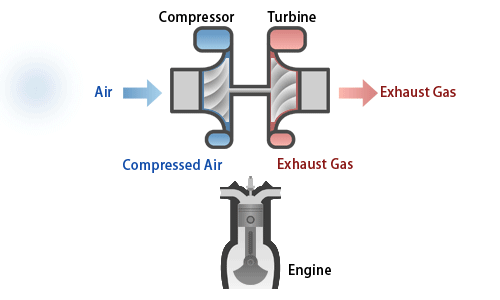What is a turbocharger?
Introduction
Automobile is indispensable in our daily life. Most of them are driven by a gasoline or diesel engine. Turbocharger has contributed to improve both power performance and environmental performance.
Function

Engine mixes intake air and fuel, compresses it with pistons and burns it in engine cylinders. The engine converts the thermal energy of the burned gas to shaft power by letting the burned gas expand and push pistons. Supercharging technology has been widely used to pushes air into engine to increase engine power.
Turbocharger is a supercharging device powered by exhaust gas. Turbocharger utilizes otherwise wasted exhaust gas to rotate turbine shaft and drives a coaxially connected compressor to feed compressed air to the engine. Turbocharger is high speed rotating machine designed to be used in harsh conditions, exposed to over 950°C exhaust gas and rotates up to 300,000 rotations per minute. There are three reasons to equip turbochargers to engines.
Power enhancement:
Turbocharger helps deliver more engine power than naturally aspirated engine with same displacement. Turbocharger enables deliver the same power and torque as naturally aspirated engine with "down-sized" engine, which helps reducing pumping loss and friction loss of engine, leading to better fuel economy. In addition, vehicle weight can be lighter thanks to the smaller powertrain system for diesel engines, large displacement gasoline engines or engines for races by turbocharging.
Thermal efficiency improvement:
Thermal efficiency of diesel engine apparently improves with turbocharging, especially because the throttle-less structure matches well with turbocharging and it has low risk of abnormal combustion such as knocking and pre-ignition. Thermal efficiency improvement of gasoline engine mostly owes to stoichiometric combustion and the effect of turbocharging in terms of combustion cycle theory is limited. Fuel economy indeed improves together with pumping loss decrease by downsizing.
Cleaner exhaust gas:
Turbocharger is effective in lowering soot of diesel engine that it cannot meet latest emission regulations.
Small but powerful
A 10-ton truck with rated power around 300 kW weighs about 1 ton. Such engine usually equipped with a 20 kg turbocharger with 80 kW compressor power. This compressor power is roughly equivalent with 1.2L gasoline engine, which weighs about 100 kg. If a motor-drive electric compressor is used to deliver the same amount of air instead of turbocharger, 80 kW extra power needs to be generated by the engine, which is roughly equivalent to 200 kg weight increase.
Contribution to carbon neutral
Electrification of vehicle powertrain as well as spread of battery electric vehicle (BEV) is accelerating toward the reduction of CO2 emissions and the carbon neutrality of the future. Since BEVs have challenges in range, charging time, access to charging facilities and battery recycle, vehicles with other options including engines with super-high thermal efficiency over 50%, engines using carbon-neutral fuels such as hydrogen and biomethane, and fuel cells are under development. These engines cannot be realized without supercharging technologies. Electric turbocharger is also essential for improving the system efficiency of fuel cells. IHI will contribute toward carbon neutrality with various supercharging technologies.

